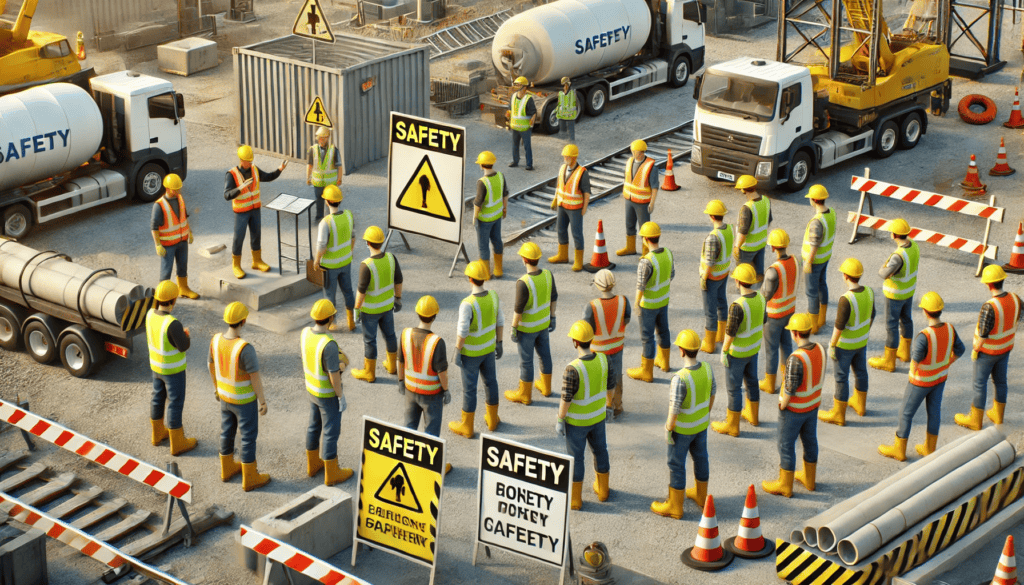Construction Site Safety: Best Practices for a Secure Work Environment
Safety on construction sites is of paramount importance. The nature of construction work involves numerous hazards, but with the right practices and precautions, the risk of accidents and injuries can be significantly reduced. This article explores essential safety practices for construction sites to ensure a secure working environment.
The Importance of Personal Protective Equipment (PPE)
Wearing appropriate PPE is crucial for protecting workers from potential hazards on construction sites. Employers must provide and enforce the use of PPE.
- Hard Hats: Protect the head from falling objects and other impact hazards.
- Reflective Vests: Enhance visibility, especially in low-light conditions or when working near moving vehicles.
- Gloves: Protect hands from cuts, abrasions, and chemical exposure.
- Safety Boots: Provide protection against foot injuries from heavy objects and punctures.
Conducting Regular Equipment Inspections
Proper maintenance and inspection of equipment are essential to prevent accidents caused by equipment failure.
- Daily Checks: Conduct daily inspections of all equipment before use to ensure it is in good working condition.
- Maintenance Logs: Keep detailed maintenance logs for all machinery and equipment. Ensure that any issues are promptly addressed.
- Qualified Operators: Ensure that only trained and qualified personnel operate machinery and equipment.
Ensuring Site Organization and Cleanliness
A well-organized and clean construction site reduces the risk of accidents and enhances productivity.
- Clear Pathways: Keep pathways and access routes clear of obstructions to prevent trips and falls.
- Proper Storage: Store materials and tools properly when not in use. Ensure that hazardous substances are securely stored and labelled.
- Waste Management: Implement a waste management plan to regularly remove debris and waste from the site.
Conducting Safety Briefings and Training
Regular safety briefings and training sessions are vital for keeping workers informed about safety protocols and procedures.
- Daily Briefings: Conduct daily safety briefings to discuss the tasks for the day, potential hazards, and safety measures.
- Induction Training: Provide comprehensive safety training for new workers, including site-specific hazards and emergency procedures.
- Refresher Courses: Regularly conduct refresher courses to keep all workers updated on the latest safety practices.
Implementing Safety Signs and Barriers
Safety signs and barriers play a crucial role in alerting workers to potential hazards and keeping unauthorized personnel away from dangerous areas.
- Prominent Signs: Display safety signs prominently throughout the site to warn of hazards such as falling objects, high voltage, and restricted areas.
- Barriers and Fencing: Use barriers and fencing to cordon off hazardous areas, such as open excavations and areas where heavy machinery is operating.
- Access Control: Implement access control measures to ensure that only authorized personnel enter hazardous areas.
Emergency Preparedness and Response
Being prepared for emergencies can significantly reduce the impact of accidents and incidents on construction sites.
- Emergency Plans: Develop and communicate a comprehensive emergency response plan, including evacuation procedures and contact information for emergency services.
- First Aid Kits: Ensure that first aid kits are readily available and stocked with necessary supplies. Train workers in basic first aid.
- Fire Safety: Install fire extinguishers and smoke detectors. Conduct regular fire drills to ensure workers know how to respond in the event of a fire.
Addressing Specific Construction Hazards
Construction sites present unique hazards that must be addressed with targeted safety measures.
- Working at Heights: Use proper fall protection systems, such as guardrails, safety nets, and harnesses. Conduct regular inspections of fall protection equipment.
- Excavation Safety: Implement trenching and excavation safety measures, including shoring, sloping, and benching to prevent cave-ins.
- Electrical Safety: Ensure that electrical systems are installed and maintained by qualified electricians. Use proper grounding and insulation to prevent electrical accidents.
Conclusion
Ensuring safety on construction sites requires a comprehensive approach that includes the use of PPE, regular equipment inspections, site organisation, safety briefings, and emergency preparedness. By implementing these best practices, construction companies can create a secure work environment that protects workers and enhances productivity.
By prioritizing safety and fostering a culture of vigilance and responsibility, construction sites can minimise the risk of accidents and ensure the well-being of all workers.

